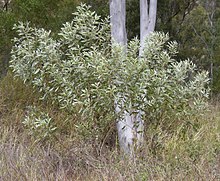
Acacia translucens, commonly known as poverty bush, is a shrub that is endemic to a large area of north western Australia.
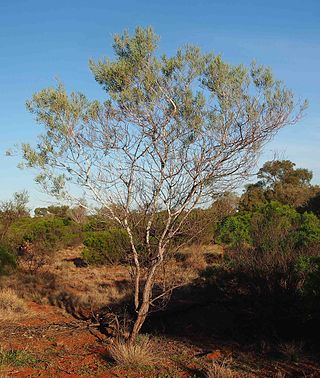
Acacia murrayana is a tree in the family Fabaceae. It has numerous common names, including sandplain wattle, Murray's wattle, fire wattle, colony wattle and powder bark wattle, and is endemic to arid areas in every mainland state except Victoria.

Acacia colei is a perennial bush or tree native to northern Australia. A common name for it is Cole's wattle. Acacia colei blooms from May through September and the flowers are bright yellow.
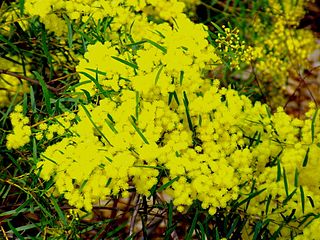
Acacia fimbriata, commonly known as the fringed wattle, Brisbane golden wattle, or just the Brisbane wattle, is a species of Acacia that is native to much of the east coast of Australia. It is one of the floral emblems of the city of Brisbane, Queensland.

Acacia bivenosa, commonly known as two-nerved wattle, two-veined wattle or hill umbrella bush, is a species of Acacia found in northern Australia.

Acacia tumida, known colloquially as pindan wattle, spear wattle or wongai, is a species of Acacia native to northern and western Australia.

Acacia leptocarpa, commonly known as north coast wattle, is a shrub or small tree native to New Guinea and coastal regions of northern Australia.

Acacia adoxa, commonly known as the grey-whorled wattle, is a species of flowering plant in the family Fabaceae and is endemic to north-western Australia. It is a dense, low-lying shrub with linear, more or less cylindrical phyllodes in whorls of 6 to 10, heads of golden-yellow flowers, and flat, sticky pods.

Acacia ancistrocarpa, commonly known as Fitzroy wattle, is a shrub belonging to the genus Acacia and the subgenus Juliflorae. The shrub is also known as fish hook wattle, pindan wattle and shiny leaved wattle.

Acacia aptaneura, commonly known as slender mulga, is a shrub belonging to the genus Acacia and the subgenus Juliflorae. It is native to central and western parts of Australia.

Acacia elachantha is a shrub belonging to the genus Acacia and the subgenus Juliflorae. It is native to arid parts of central and northern Australia.

Acacia hammondii, also known as Hammond's wattle, is a tree or shrub belonging to the genus Acacia and the subgenus Juliflorae that is native across northern Australia.

Acacia hilliana, commonly known as Hill's tabletop wattle but also known as sandhill wattle and Hilltop wattle, is a shrub belonging to the genus Acacia and the subgenus Juliflorae. It is native to northern Australia.

Acacia neurocarpa is a shrub or tree belonging to the genus Acacia and the subgenus Juliflorae that is endemic to northern Australia.

Acacia orthocarpa, also commonly known as Pilbara weeping wattle, needle-leaf wattle or straight-podded wattle, is a shrub or tree belonging to the genus Acacia and the subgenus Juliflorae that is endemic to tropical parts of northern Australia. The indigenous Nyangumarta peoples know it as yartupu.

Acacia stipuligera is a tree or shrub belonging to the genus Acacia and the subgenus Juliflorae. It is native to arid and tropical parts of northern Australia.

Acacia tenuissima, commonly known as narrow-leaved wattle, broom wattle, minyana, slender mulga or slender wattle, is a shrub belonging to the genus Acacia and the subgenus Juliflorae endemic to temperate and tropical areas of Australia. Indigenous Australians the Kurrama peoples know the plant as Janangungu and the Banyjima know it as Murruthurru.

Acacia dictyophleba, also known as the sandhill wattle, waxy wattle, feather veined wattle, and spear tree, is a shrub belonging to the genus Acacia and the subgenus Phyllodineae, found in Australia. The Nyangumarta peoples know the plant as Langkur or Lungkun; the Thalanyji know it as Jabandi; and the Pintupi know it as mulyati.
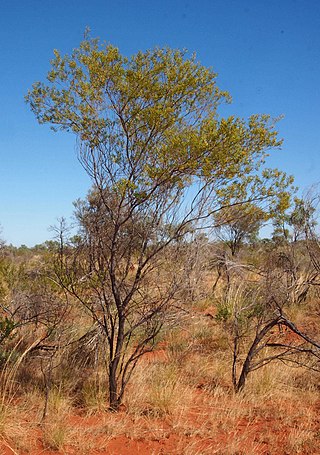
Acacia melleodora, commonly known as scented wax wattle, waxy wattle, honey wattle or honey scented wattle, is a shrub belonging to the genus Acacia and the subgenus Phyllodineae that is endemic to arid parts of central Australia.
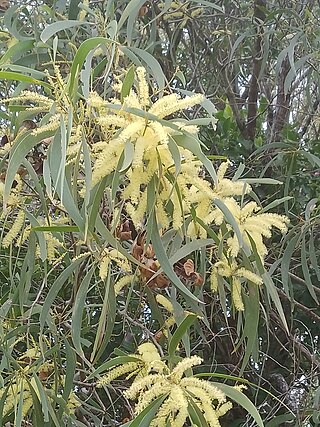
Acacia disparrima, also commonly known as southern salwood, is a shrub or tree belonging to the genus Acacia and the subgenus Juliflorae that is native to north eastern Australia.




